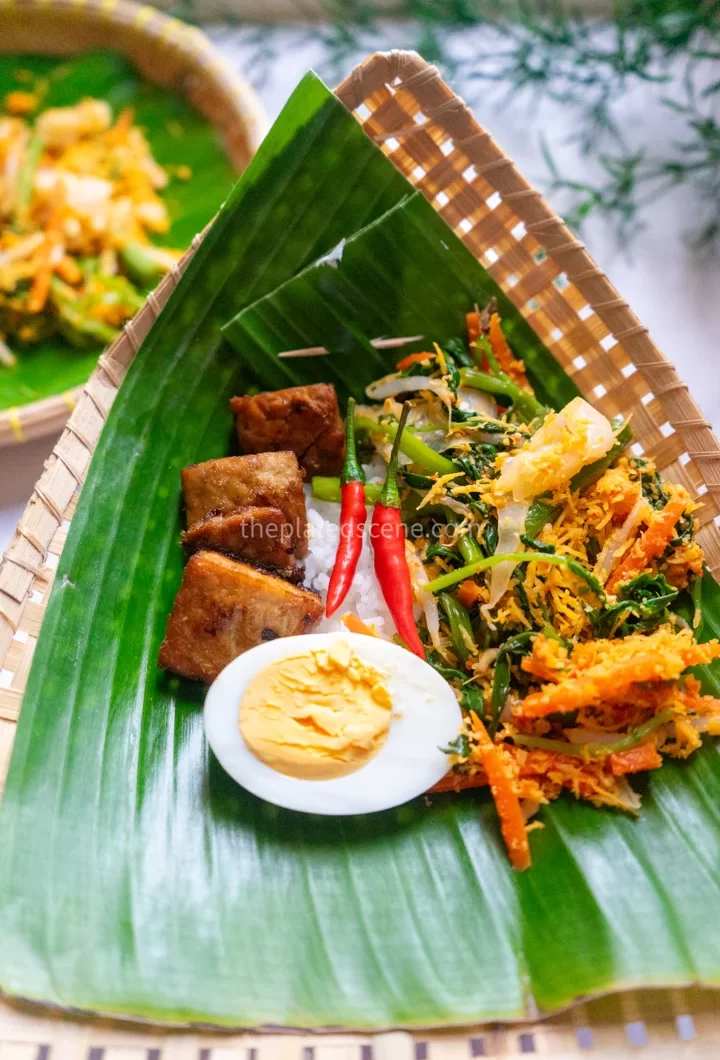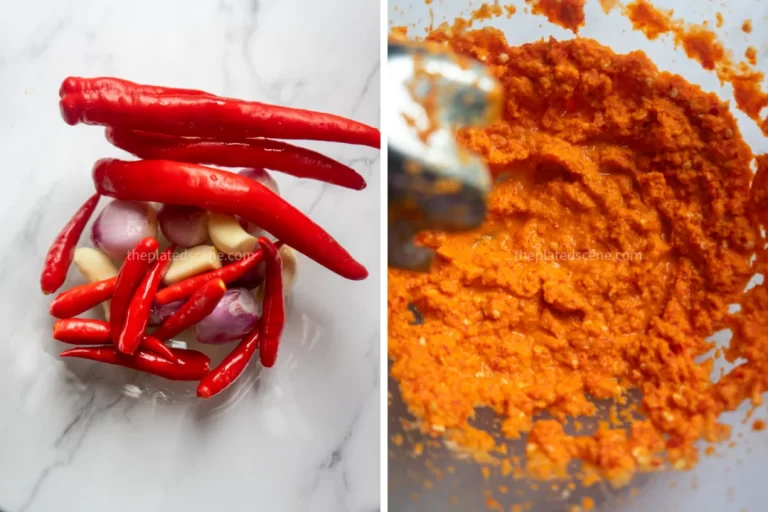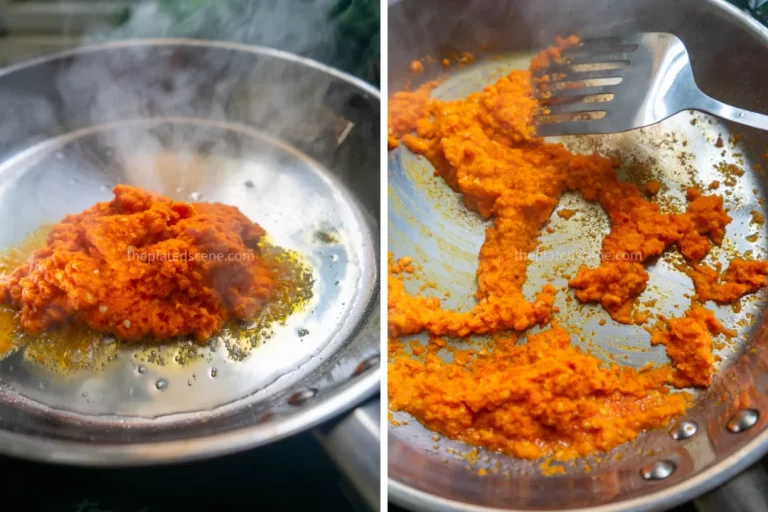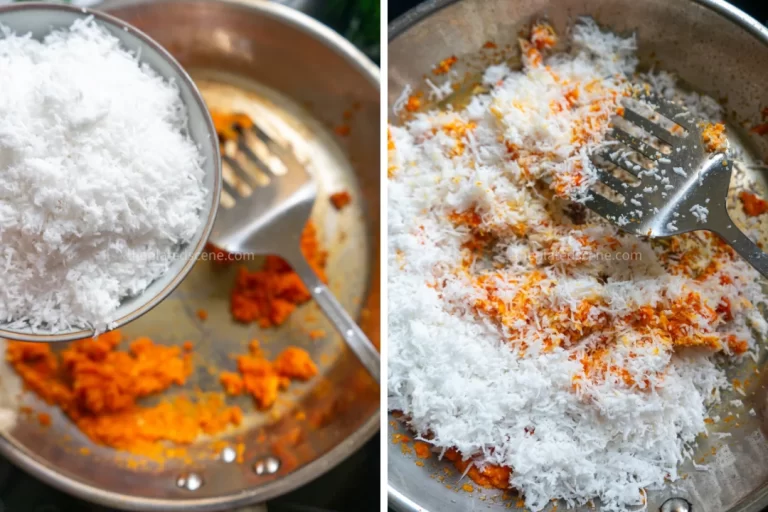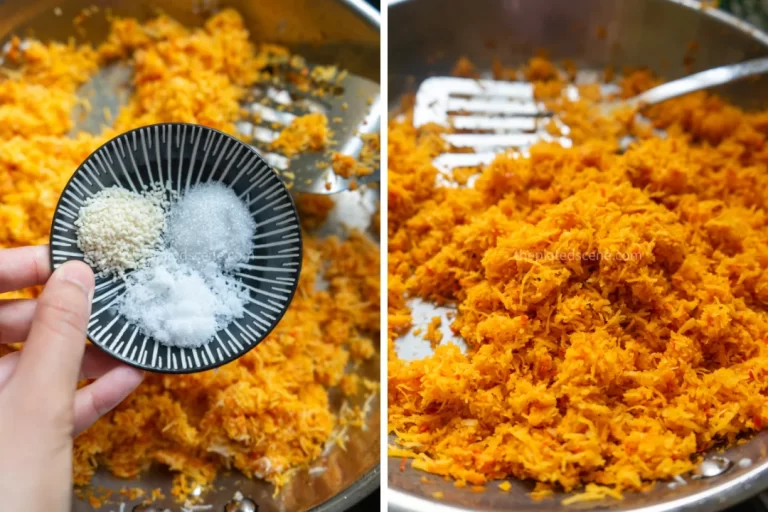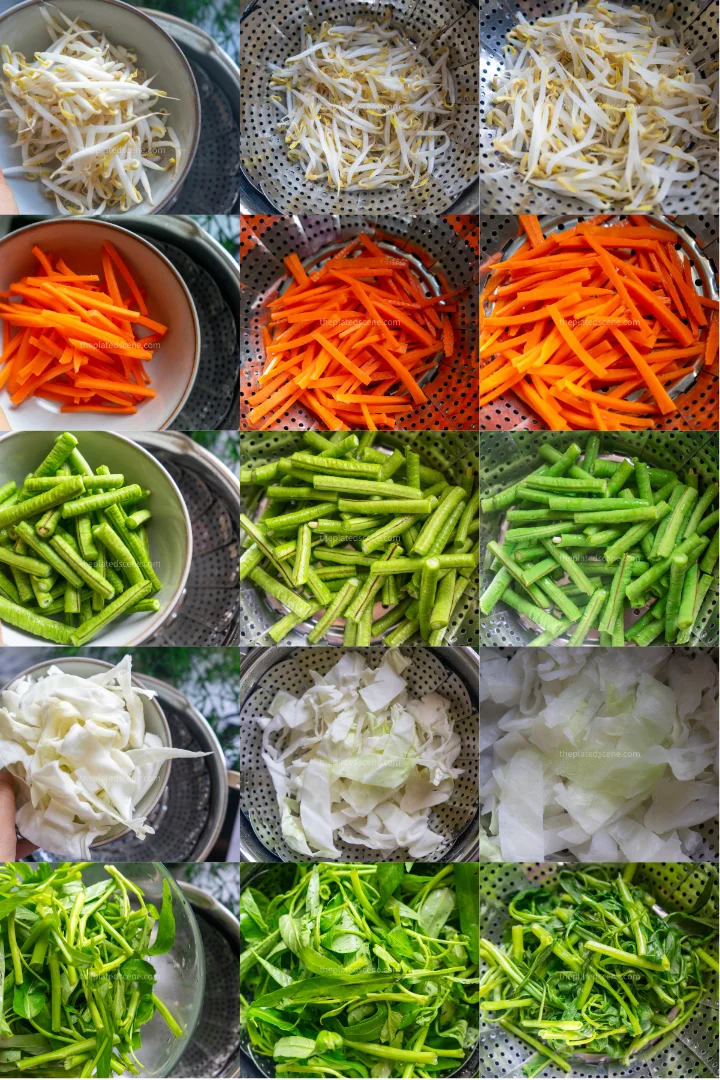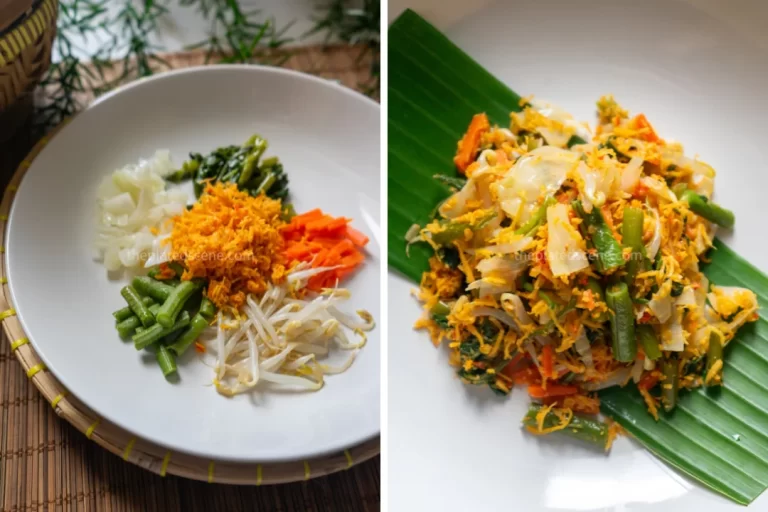Whenever I think about urap sayur, I’m transported back to those quiet, misty mornings in my childhood neighborhood. My mother would wake up early, often before the sun had fully risen, and walk to the fresh market just a few blocks from our house. The market was already alive with the aroma of herbs, spices, and cooked rice. There, she would buy a generous portion of urap sayur from her favorite stall—run by an old woman who, according to my mom, made the best urap in town.
The urap would be warm, fragrant, and packed in brown paper. It was always a humble mix of vegetables, yet it tasted like the most comforting thing in the world. We’d eat it together at the small dining table, often with a side of rice or just as it was, and it became one of my favorite breakfasts. I didn’t fully appreciate it then, but those simple mornings shaped my deep love for urap sayur. As I recreate this dish in my kitchen, I feel a sense of closeness to home and to my mother, who passed down this tradition with so much care.
Table of Contents

The Origins of Urap Sayur
Urap sayur has a long and rich history within Indonesian cuisine, especially across Java and Bali. The name “urap” comes from the Javanese word meaning “to mix,” that’s essentially what this dish is: a mixture of steamed vegetables tossed in a spiced, grated coconut dressing. In Bali, the dish is often part of ceremonial offerings, reflecting its cultural significance. While it’s seen as a side dish today, grab sayur once held deeper meaning as part of community meals and temple rituals.
Unlike other vegetable dishes, urap sayur relies on fresh, natural ingredients without frying or heavy sauces. It reflects the balance and wholesomeness of traditional Indonesian cooking. The core idea is to let the flavors of the vegetables shine, enhanced by a fragrant coconut blend that ties everything together.
Over time, urap sayur has become a staple in households, warungs, and markets all over Indonesia. Its simplicity makes it accessible, yet its taste makes it unforgettable.
What Does Urap Sayur Taste Like?
The first thing you’ll notice when you take a bite of crab sayur is the unique combination of freshness and spice. The steamed vegetables are soft but retain a slight crunch, offering a satisfying texture. The grated coconut dressing truly defines the flavor: it’s slightly sweet, a little salty, deeply aromatic, and spiced just right.
There’s a subtle heat from chili, a zing from lime leaves, and an earthy depth from the addition of kencur—a rhizome that gives the dish its unmistakable character. The dressing clings to every strand of vegetable, creating a mouthful layered in taste and texture. It’s a complex but grounded flavor profile—every bite feels nourishing and indulgent.
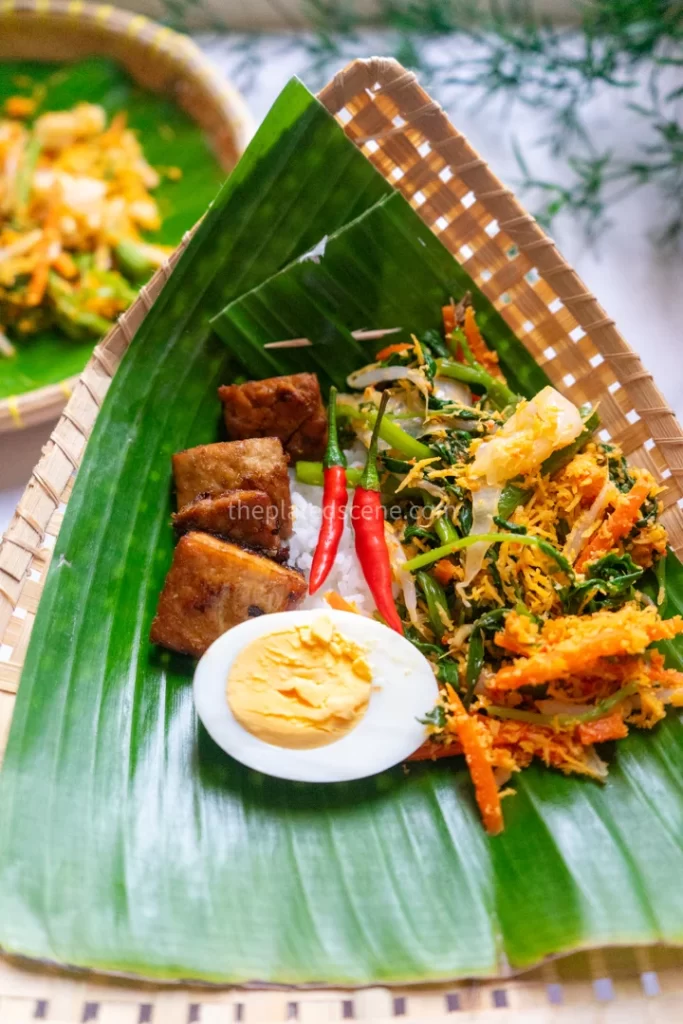
Urab vs Urap: What’s the Difference?
If you’ve encountered both urab and urap in cookbooks or food blogs, you might wonder—are they two different dishes? The short answer is no. Urab and urap refer to the same traditional Indonesian vegetable dish with spiced grated coconut, known more formally as urap sayur. The difference lies in regional language and pronunciation, not in the dish itself.
“Urap” is the spelling most commonly used in Javanese and is widely understood across Indonesia. It appears in most Indonesian-language cookbooks and food menus, especially in Java, where the dish is a staple in home cooking and traditional ceremonies.
“Urab”, on the other hand, is the Balinese spelling and pronunciation. In Bali, urab is often part of ceremonial offerings, temple feasts, and family gatherings. The ingredients and preparation methods are almost identical. Still, the dish may have a more complex spice base in Balinese versions—sometimes including fried shallots, shrimp paste, or additional herbs like torch ginger.
So while urap sayur and urab sayur may sound slightly different, they’re essentially two names for the same beloved dish. Choosing which term to use usually comes down to the cultural or regional context you want to highlight in your recipe.
In this post, I use urap sayur to reflect the Javanese roots I grew up with. Still, I honor both versions as equally delicious and deeply rooted in Indonesian culinary heritage.
Kencur: The Soul of Urap Sayur
To truly understand urap sayur, you need to understand kencur. Known as aromatic ginger or sand ginger in English, kencur looks like a smaller, rounder version of galangal. But it has a much more intense aroma—something between ginger, camphor, and ginseng. It’s sharp, almost medicinal, and just a little of it goes a long way.
In urap sayur, kencur gives the dressing its depth and a hint of mystery. Without it, the dish can feel flat or overly sweet. My mother used to say that kencur was the “heart” of the urap—remove it, and it’s just a vegetable salad. She would crush it gently with garlic and chili, mixing it into the freshly grated coconut, transforming a handful of simple ingredients into a fragrant, addictive dish.
While it might be hard to find fresh kencur outside of Southeast Asia, many Asian grocery stores carry the dried or powdered version, which, when rehydrated, works beautifully in this recipe.
Javanese vs Balinese Urap Sayur
While the essence of urap sayur remains consistent across regions, there are notable differences between the Javanese and Balinese versions. Growing up in Java, I was most familiar with the Javanese style. It’s generally milder and slightly sweeter and uses ingredients like palm sugar and more lime leaves. The spice blend is balanced, and the coconut dressing leans toward aromatic rather than fiery.
In contrast, the Balinese urap is bolder and more assertive in flavor. It’s often spicier and sometimes includes ingredients like shrimp paste or fried shallots to boost umami. The preparation is also more ceremonial, often as part of a nasi campur or during religious rituals. The use of torch ginger or Balinese base genep (a complex spice paste) in some versions makes Balinese urap distinct and richer in taste.
Both are delicious, and which one you prefer may depend on personal history or how much heat you can handle!
Vegetables Commonly Used in Urap Sayur
One of the best things about urap sayur is its versatility. Traditionally, it’s made with a mix of seasonal, local vegetables that are lightly steamed or blanched. Some of the common choices include:
- Long beans (kacang panjang), cut into bite-sized pieces
- Spinach or cassava leaves (daun singkong)
- Bean sprouts (tauge), just briefly blanched
- Cabbage, thinly sliced and softened
- Kangkung (water spinach), popular in both Java and Bali
- Corn kernels or young jackfruit in some regional twists
These vegetables provide a balance of crunch, softness, and green freshness. The goal is to have a variety of textures that soak up the spiced coconut dressing without becoming soggy. My mother would often go with whatever looked freshest in the market—some days it would be mostly spinach and sprouts, while on others, she’d mix in cabbage or even a bit of finely sliced turmeric leaves for aroma.
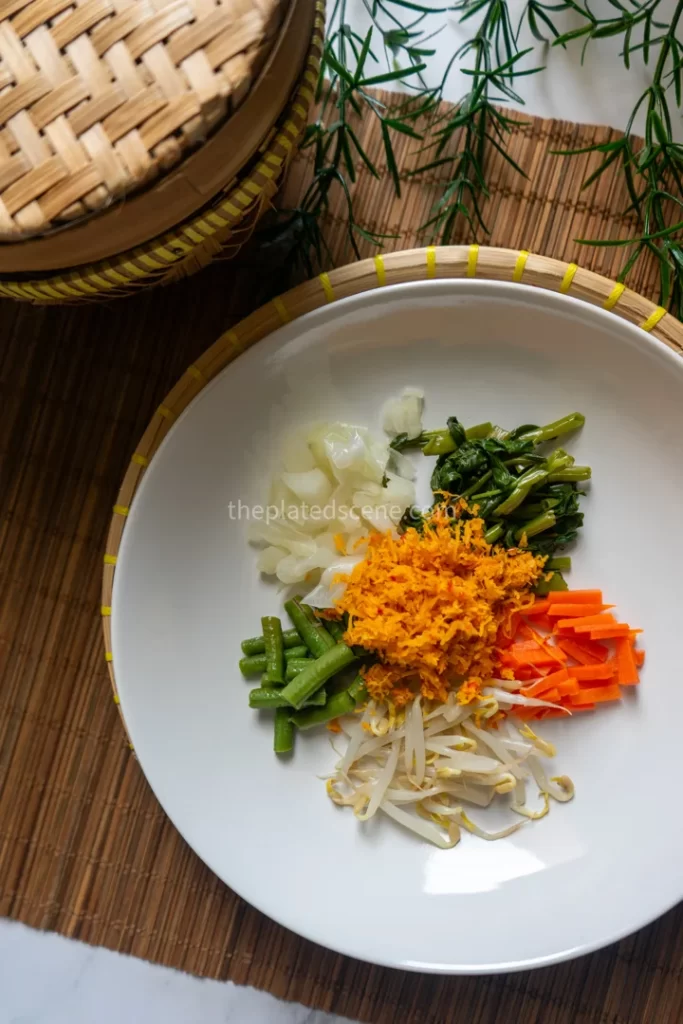
Urap Sayur vs Lawar Bali
If you’re familiar with Balinese food, you might wonder how urap sayur differs from lawar, another traditional dish involving vegetables and coconut. The main difference lies in complexity and use of protein. Lawar often includes minced meat or blood (in traditional preparations), mixed with grated coconut, herbs, and spices. It’s a more decadent and ceremonial dish, usually served during special occasions.
Urap sayur, on the other hand, is purely vegetarian and lighter. You can enjoy it as a regular meal without feeling weighed down. While both dishes use grated coconut and aromatic spices, urap sayur is more everyday, humble, and accessible.
That said, the lines sometimes blur—especially in Bali, where variations of lawar might resemble urap, depending on the ingredients and context. But if you’re after something plant-based, urap sayur is the one to go for.
Variations of Urap Sayur
Like many Indonesian dishes, urap sayur has evolved and adapted across regions and families. Here are a few common variations:
- Urap with corn: Sweet corn kernels add a pop of sweetness and color.
- Urap daun pepaya: Made with papaya leaves, which are bitter and pair well with a more decadent coconut dressing.
- Urap with jackfruit: Some versions incorporate young jackfruit for a meaty texture.
- Vegan-friendly urap: While traditional urap is vegan, some add fried tempeh or tofu for protein.
- Modern twists: I’ve seen versions that use kale, broccoli, or even zucchini in urban Indonesian restaurants.
No matter the variation, the soul of urap sayur remains the same—vegetables brought to life by a spiced coconut dressing. It’s one of those dishes that invites creativity while still staying rooted in tradition.
Things to Watch Out For
Making urap sayur is simple, but a few things can make or break the dish:
- Freshness of coconut: Always use fresh grated coconut, if possible. Frozen grated coconut is a decent substitute, but stale or desiccated coconut will dull the flavor and texture.
- Don’t over-steam the vegetables. They should be cooked but not mushy. Retaining a bit of bite keeps the dish refreshing.
- Balance the seasoning: The coconut mixture should be balanced—salty, aromatic, spicy, and just a little sweet. Always taste before mixing.
- Watch the kencur: It’s powerful! A little too much and the flavor can become overpowering. Start small and adjust as you go.
- Serve fresh: Urap sayur is best enjoyed shortly after it’s mixed. Over time, the vegetables release water, and the coconut loses its texture.
Ingredients for Urap Sayur
To make a delicious plate of urap sayur, you’ll need a variety of fresh vegetables, aromatic blended spices, and grated coconut. This dish is about texture, balance, and freshness, so try using the best-quality ingredients. If some are hard to source, helpful substitutions are listed below.

Vegetables
- Kangkong (water spinach)
Known for its hollow stems and tender leaves, kangkong cooks quickly, adding a fresh, slightly earthy flavor to urap sayur. If unavailable, you can substitute with spinach or even morning glory. - Beansprouts
These add a nice crunch and lightness to the dish. Always use fresh white sprouts, blanching them briefly in hot water to preserve their texture. - Long beans
These are firmer than regular green beans and have a slight bitterness that pairs beautifully with the sweet-spicy coconut. Slice them into 3–4 cm pieces before blanching. If long beans are hard to find, French beans or regular green beans work well , too. - Cabbage
Thinly shredded cabbage provides softness and volume to the dish. Both white and green cabbage can be used. Steam or blanch just until slightly wilted. - Carrot
Carrots add color and natural sweetness to urap sayur. Julienne them into thin strips to match the shape of the other vegetables. For a variation, you can also try using pumpkin or zucchini.
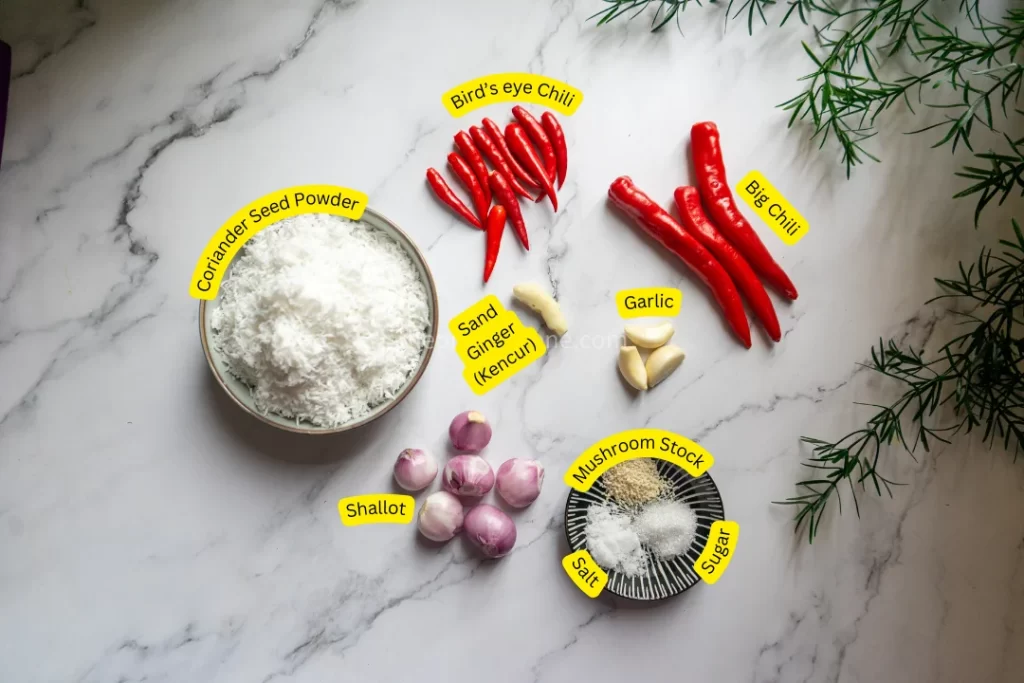
Blended Spices
These ingredients are blended to create the aromatic base of urap sayur. For convenience, you can use a mortar and pestle for a traditional touch or a food processor.
- Shallots
Shallots add sweetness and fragrance. Red Asian shallots are preferred, but you can also use European shallots or substitute with red onion in a pinch. - Garlic
Garlic brings warmth and depth to the spice paste. If the flavor is too sharp, frying it lightly before blending can mellow it. - Big red chili (cabe besar)
These large, mildly spicy chilies give the dressing a reddish hue without overwhelming heat. If you want a milder urap sayur, reduce the quantity or remove the seeds. - Bird’s eye chili (cabe rawit)
These small chilies pack a punch and bring the heat. You can adjust the amount based on your spice tolerance or omit entirely for a milder version. - Kencur
Kencur is the signature aromatic in urap sayur, contributing an earthy, medicinal scent and flavor. It’s essential for authenticity. Fresh kencur is best, but if unavailable, you can use dried kencur soaked in warm water or substitute it with a very small amount of galangal (though the flavor won’t be the same).
Other Ingredients
- Freshly grated coconut
This is the heart of urap sayur. If possible, use freshly grated coconut—either steamed or lightly toasted to enhance the aroma. If you’re outside Indonesia, frozen grated coconut (available in Asian supermarkets) is the next best thing. Avoid desiccated coconut, which won’t provide the same texture or flavor. - Salt
Essential for seasoning and balance. Sea salt or acceptable table salt both work fine. - Sugar
A touch of sugar balances out the heat and enhances the coconut’s natural sweetness. Palm sugar can be used for a deeper flavor if you prefer a more traditional touch. - Mushroom stock powder
It adds umami depth to the dish and is especially useful in plant-based urap sayur. If unavailable, you can substitute with vegetable bouillon or leave it out entirely if your coconut is already flavorful.
Step-by-Step Instructions to Make Urap Sayur
Making urap sayur at home is a straightforward and rewarding process. The key lies in balancing the fresh vegetables with a well-seasoned coconut dressing. Follow these detailed steps to get the best results, along with some helpful cooking tips and things to watch out for.
1. Prepare and blend the spice ingredients
Begin by preparing the spice paste. Combine the shallots, garlic, big red chilies, bird’s eye chilies, and kencur in a blender or food processor. Here is the link for the immersion blender that I use. Blend everything into a smooth paste.
You can pound the ingredients with a mortar and pestle if you prefer a more traditional method. This releases the natural oils and intensifies the paste’s aroma.
Tip: Add a tablespoon of water to help the blender process the ingredients smoothly, but don’t make it too watery—the paste should be thick.
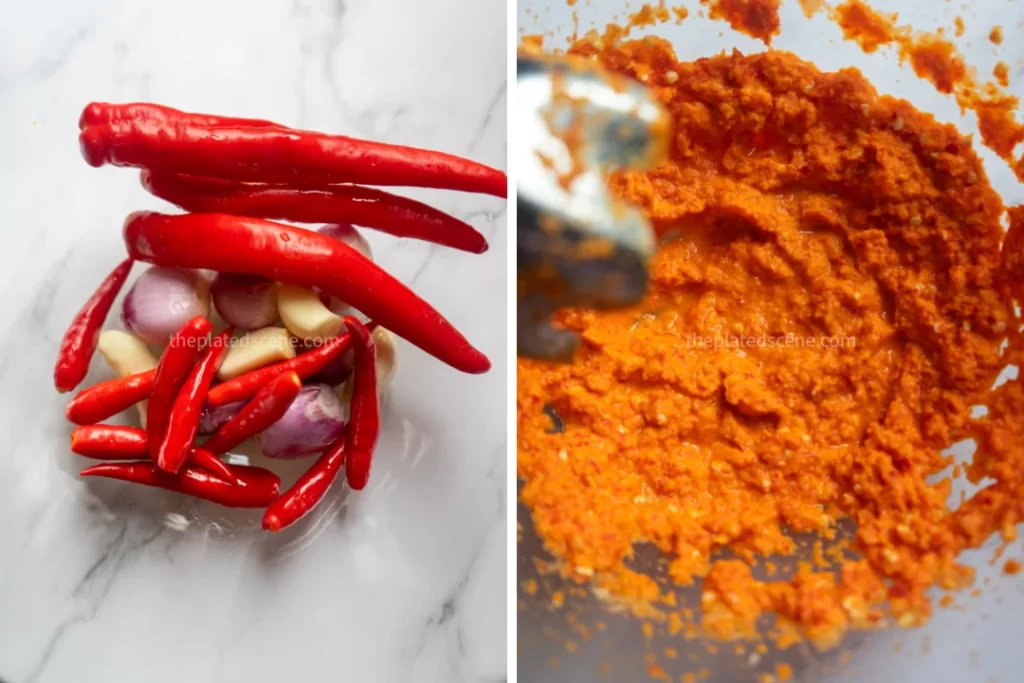
2. Sauté the blended spice paste until fragrant
In a dry pan or with just a tiny splash of oil, sauté the spice paste over medium heat. Stir frequently until the paste turns slightly darker and releases a fragrant aroma. This usually takes about 5–7 minutes.
This step helps mellow out the sharpness of the garlic and shallots and brings out the earthy depth of the kencur.
Watch out: Don’t let the paste burn, especially if you use little or no oil. Stir constantly and reduce the heat if needed.

3. Add the shredded coconut and cook until dry
Once the spice paste is cooked, add the freshly grated coconut to the pan. Mix it thoroughly to ensure the coconut is evenly coated with the spices. Cook the mixture on low to medium heat for another 5–7 minutes, stirring regularly.
You’re looking to reduce the moisture in the coconut and allow it to absorb the spices fully.
Tip: If you’re using frozen grated coconut, ensure it’s fully thawed and squeezed dry before adding it to the pan. This will help speed up the drying process.

4. Season the coconut dressing
Add the salt, sugar, and mushroom stock powder to the coconut mixture. Stir well to combine. Adjust the seasoning to taste—it should be slightly sweet, savory, and aromatic.
Watch out: The seasoning should be slightly bolder than usual because the steamed vegetables will dilute the flavor once mixed.
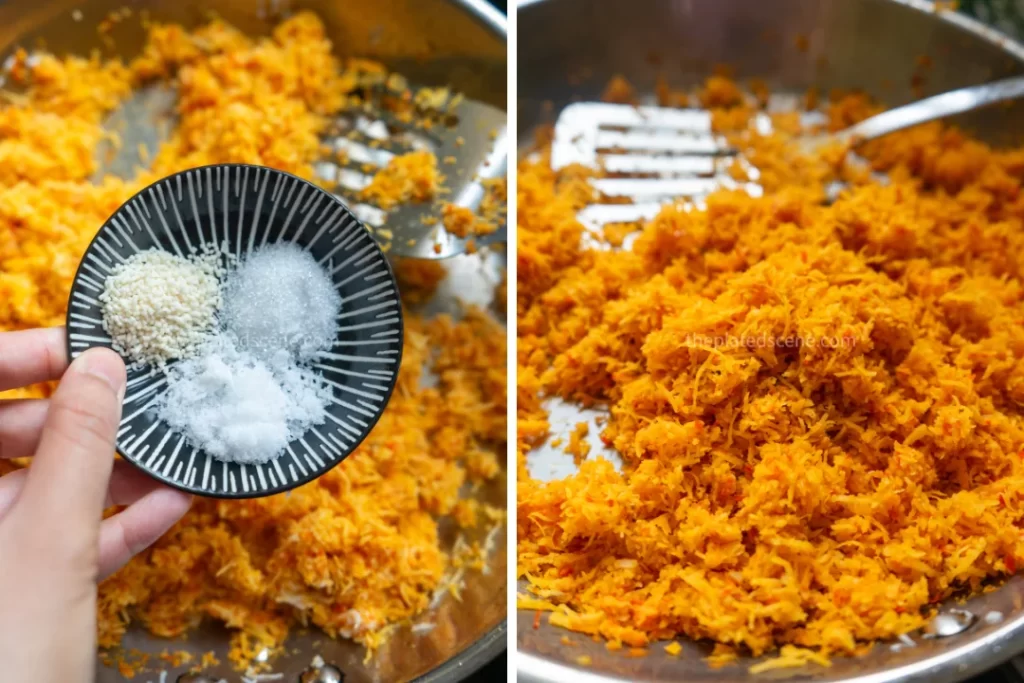
5. Prepare the vegetables
While the coconut mixture is cooling slightly, prepare your vegetables. Cut them into bite-sized pieces for even cooking and easy mixing. Here’s a simple guideline:
- Kangkong: Separate the leaves and stems, and cut the stems into 4–5 cm pieces
- Long beans: slice into 3–4 cm segments
- Cabbage: shred thinly
- Carrot: julienne into matchstick-size strips
- Beansprouts: Trim the tails if preferred, leave whole
Tip: Uniform cuts help the vegetables cook evenly and make the final presentation more appealing.
6. Steam the vegetables carefully
Steam the prepared vegetables separately or in groups with similar cooking times. Long beans and carrots take longer, while kangkong and cabbage need a quick steam. Bean sprouts should be steamed briefly, just 30 seconds to 1 minute, to keep their crunch.
Watch out: Avoid overcooking. The vegetables should be tender but not mushy. They should still have a bit of bite and a bright color to contrast with the coconut dressing.

7. Mix and serve the urap sayur
In a large bowl, combine the steamed vegetables with the coconut dressing. Use clean hands or tongs to gently toss until the vegetables are evenly coated.
Tip: Only mix right before serving to maintain the texture of the vegetables. If you’re preparing in advance, keep the dressing and vegetables separate until it’s time to eat.

What to Serve with Urap Sayur
While urap sayur is delicious, it becomes even more satisfying when paired with complementary side dishes. Its sweet, spicy, and coconut-forward flavor brings freshness and balance to many Indonesian meals. Here are some pairing suggestions to help you turn urap sayur into a wholesome and flavorful plate.
1. Steamed rice (nasi putih)
This is the simplest and most traditional way to enjoy urap sayur. The plain rice absorbs the richly seasoned coconut dressing, making it a comforting everyday meal.
2. Tofu and tempe bacem
For a sweeter, more aromatic pairing, try bacem-style tofu and tempeh. This Javanese favorite is simmered in palm sugar, spices, and tamarind before being lightly fried. Its caramelized flavor goes perfectly with the earthy freshness of urap sayur.
3. Bakwan (vegetable fritters)
Bakwan adds crunch and a savory kick to the plate. These deep-fried vegetable fritters are often made with cabbage, carrot, and flour batter—making them a hearty companion to the lighter texture of urap sayur.
4. Telur balado (chili eggs)
The rich, spicy tomato-chili sauce of telur balado pairs beautifully with the mildly sweet and fragrant flavor of urap sayur. Together, they create a vibrant, comforting, and flavorful contrast.
5. Ayam goreng lengkuas (fried chicken with galangal)
For a flavorful protein side, try ayam goreng lengkuas. The crispy galangal-infused chicken coating complements the soft vegetables and fragrant coconut in urap sayur, adding texture and a savory depth to the meal.
Storage Instructions for Urap Sayur
Urap sayur is flavorful when freshly prepared, especially when the vegetables are still slightly warm and the coconut dressing is aromatic. However, with a bit of planning, you can make parts of it ahead of time and store them properly. Here’s how to do it:
1. Store the coconut dressing and vegetables separately
Always store the coconut dressing and steamed vegetables in separate airtight containers for the best texture and flavor.
- The steamed vegetables should be kept in the refrigerator and consumed within 1–2 days, as they lose their texture quickly.
- However, the coconut dressing stores beautifully and can be kept in the fridge for up to 3 days or frozen for more extended storage.
2. Yes, you can freeze the coconut dressing
If you’d like to make a bigger batch of urap sayur dressing in advance, go ahead and freeze it. Transfer the cooled coconut mixture to an airtight freezer-safe container or portion it into small bags or cubes. It will keep well for up to one month in the freezer.
When ready to use, thaw it in the refrigerator overnight or defrost it in the microwave. Reheat gently in a pan before mixing with vegetables to refresh its aroma and texture.
3. Mix only before serving
To enjoy the best texture, mix the reheated coconut dressing with the freshly steamed vegetables only when you’re ready to serve. This prevents the dish from becoming watery or overly soft.
4. Reheating tips
When reheating the coconut mixture from the fridge or freezer, you may need to add a splash of water to loosen it, especially if it has dried out a little. Stir over low heat until warmed through and fragrant again.


